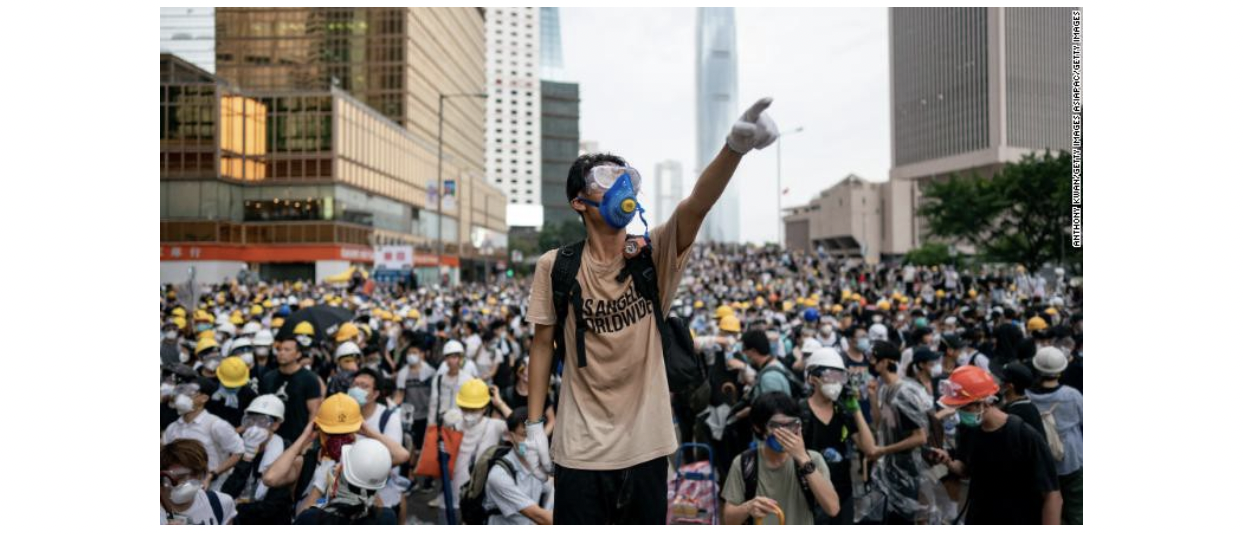Protests erupted in Hong Kong last week between the government and protestors, who oppose a proposed bill that would allow extraditions to Mainland China. The Fairbank Center asked academic contributors to give their opinion as to what these protests might mean for Hong Kong’s politics.
Contributors: Ming-Sho Ho, Tammy Lai-Ming Ho, Sebastian Veg, Ming Tak Ted Hui, Mable Chan, Helen Siu, Philippe Le Corre, and Ting Guo.
These blog posts were authored contemporaneously with the protests in Hong Kong, and reflect the authors’ views as events were unfolding.
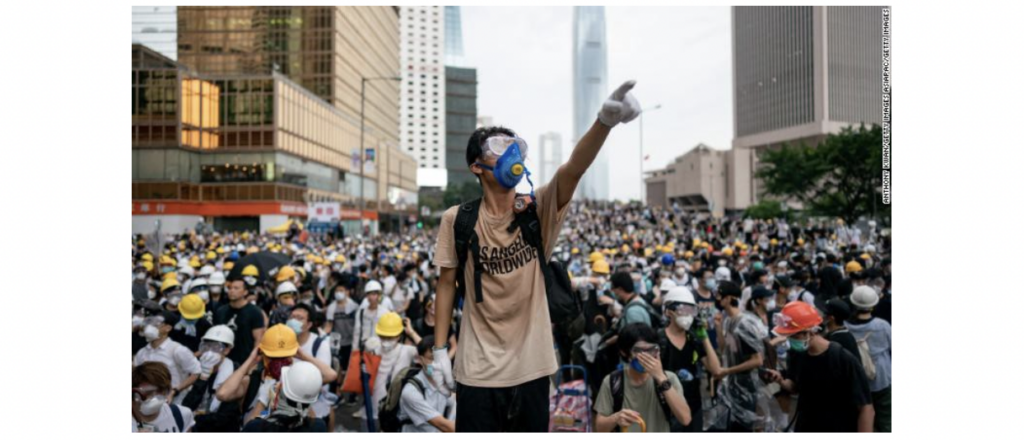
An Umbrella Movement Redux?
By Ming-Sho Ho 何明修, Professor of Sociology at National Taiwan University and 2018–19 Harvard-Yenching Institute Visiting Scholar.
On June 12, 2019, a violent melee between protestors and policemen erupted in Hong Kong over the pending revision of the extradition regulation. The regulation threatens to extradite suspects — either foreigners or locals — to the judicial authorities in the mainland.
The intensive use of pepper spray, teargas, and even rubber bullets is reminiscent of Hong Kong’s Umbrella Movement, a massive occupy protest that lasted for 79 days in 2014. In both cases, Hongkongers have expressed an impressive tenacity to resist the further encroachment of their civil liberties and political freedoms in defiance against an increasingly assertive authoritarianism in Beijing.
Since the conclusion of the Umbrella Movement, the Hong Kong government has disqualified six popularly-elected lawmakers, deprived some activists the right to participate in elections, jailed protest leaders and participants, and disbanded pro-independence organizations. Yet these repressive measures appear to have failed to intimidate Hongkongers into submission.
As I argued in my latest book, Challenging Beijing’s Mandate of Heaven: Taiwan’s Sunflower Movement and Hong Kong’s Umbrella Movement, the Umbrella Movement emerged not because of favorable political opportunities, but because of an acute perceived threat induced by the police’s aggressive use of teargas against unarmed citizens. The same mechanism seems to be present this time.
Following a successful demonstration with more than one million participants on June 9, 2019 the government provoked its opponents by issuing a callous statement that it would proceed with the revision procedure as planned. On the evening of June 11, in anticipation of protestors gathering the next day, policemen randomly detained and checked passers-by in Hong Kong’s Admiralty district. The policing on June 12 was also notably more aggressive in comparison to policing efforts during the Umbrella Movement nearly five years ago.
After the first few days of escalating confrontation between protestors and police, it is hard to tell what will come next. Protestors and the regime appear to be preparing for further conflict, which, of course, is not an encouraging sign.
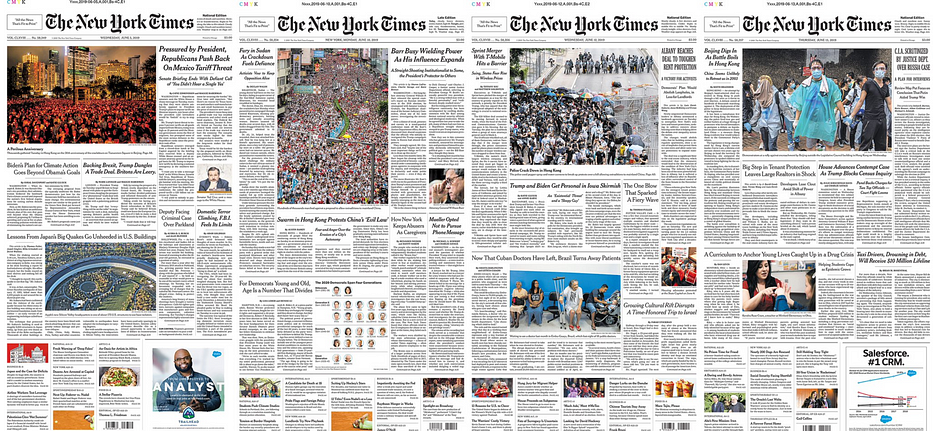
A View From Hong Kong
By Tammy Lai-Ming Ho, Associate Professor Department of English Language and Literature, Hong Kong Baptist University; Founding Co-Editor of Cha: An Asian Literary Journal and President of PEN Hong Kong.
Tuesday June 11, 2019
Last Sunday, over one million people took to the streets in protest against the Hong Kong government’s proposed amendments to the extradition law, which would have severe implications for freedom in Hong Kong. The proposed law would leave both Hongkongers and foreigners in the city at risk of being sent for trial in mainland China, where they would be unlikely to get a fair trial.
Those who turned out on Sunday sent a strong and unmistakable message to the Hong Kong government, the Chinese Communist Party, and the rest of the world that we defiantly oppose the proposed changes. Within 24 hours of the march, however, the voices and wishes of Hongkongers were disregarded when the Hong Kong government insisted on Wednesday to press ahead with the second reading of the Fugitive Offenders and Mutual Legal Assistance in Criminal Matters Legislation (Amendment) Bill.
In response to the government’s unwillingness to listen to the people of Hong Kong, independent groups, schools, businesses and individuals are determined to take part in a strike or other actions. For example, more than 130 businesses closed to allow their employees to attend the demonstration. Some churches organized a 76-hour “prayerthon.” University student unions have encouraged students to boycott classes. Two bus drivers’ unions have even declared that their members will drive more slowly as a sign of protest.
In addition to these actions , PEN Hong Kong and another ad hoc group in the city — “A Relay Hunger Strike Against Extradition Law Amendments” — comprising primarily of artists, filmmakers, scholars, and students, have decided to go on hunger strike. I am a member of both PEN Hong Kong and this ad hoc group. We believe that there are different ways Hongkongers can express their dismay with the government’s dismissal of their concerns.
The small act of PEN Hong Kong and other groups and individuals may not have a great impact when considered separately, but together, with a variety of actions, we are telling the government that the people of Hong Kong are united and that we are not ready to give up.
Thursday 13 June 2019
Tensions between protestors and police escalated on Wednesday June 12, 2019. It is reported that the police fired over 150 rounds of tear gas in one night, a number that exceeds the amount of teargas used during the entire 79-day Umbrella Movement in 2014. In addition, about 20 rounds of beanbags and several rubber bullets were fired in an attempt to overwhelm the largely young protesters.
I was not there myself but I saw the images on my computer screen. I experienced disbelief, anger, sadness, and fear. I had never even heard of ‘beanbags’ before this week. What drove the police to turn so violent? Have they gone mad? Even though we know the whole world is watching us — and being watched can be a form of protection — I don’t feel confident to say that Hong Kong is a safe place anymore. And because of this, I am going to join the relay hunger strike tomorrow. What will happen tomorrow and the day after tomorrow?
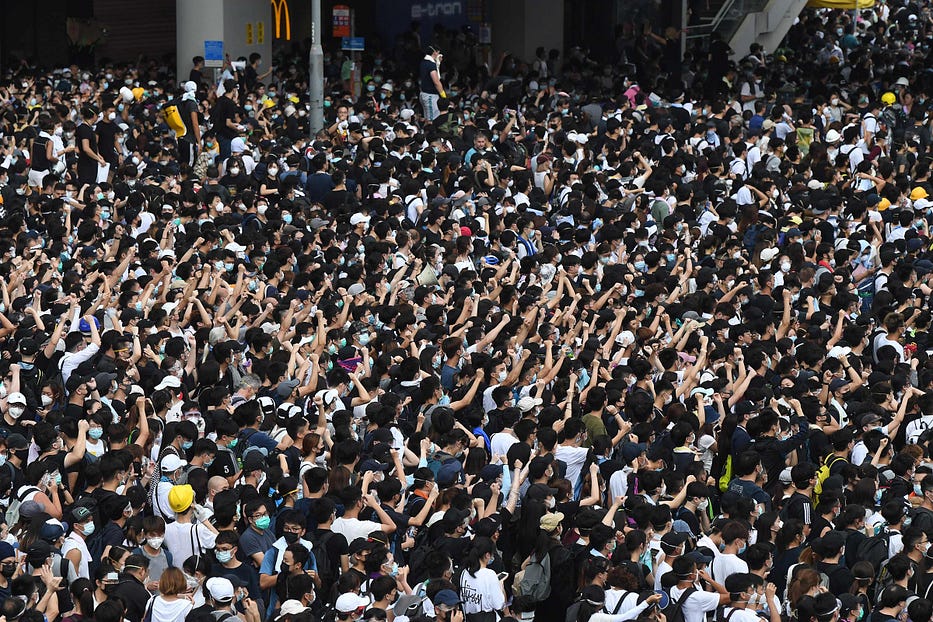
Three factors behind the protests
Sebastian Veg, Professor at EHESS in Hong Kong, examines the reasons behind why Hongkongers took to the streets in protest. Read Professor Veg’s own blog post on the events in Hong Kong on Institut Montaigne’s blog.
Hong Kong civil society is celebrating a temporary victory after the Chief Executive announced that the bill will be withdrawn from LegCo’s agenda until further notice. This is, of course, due to both the scale and the breadth of public protests that erupted against the bill.
The protests in Hong Kong can be explained by three main factors. First and foremost, polls have shown that the issue most strongly driving opposition to the bill is distrust in China’s legal system. Despite added safeguards, there is substantive opposition to the very idea of transferring suspects to China.
Second, the Hong Kong government tried to circumvent most of the procedural requirements for such a law, bypassing the relevant LegCo committee and avoiding public consultation. This comes after a long series of events that are perceived to have eroded Hong Kong’s “high degree of autonomy” enshrined in the Basic Law. These events include ad hoc interpretation of the Basic Law by the NPC to facilitate disqualification of elected lawmakers, banning a political party, the non-renewal of a foreign journalist’s visa, and ceding control over the new High Speed Rail track and a large part of the station in Kowloon to PRC law enforcement despite a shaky constitutional basis. As Anson Chan said, this bill was the straw that broke the camel’s back.
Finally, the bill kindled fears, especially but not exclusively in the business community, that there could be a significant risk for Hong Kong’s status as a business and financial platform, ultimately endangering its prosperity. This factor sets the protests apart from the 2014 pro-democracy rallies. While democracy enjoys strong support among Hong Kong public opinion, basic freedoms and in particular a predictable, reliable, and autonomous legal system enjoy overwhelming support that goes far beyond the pro-democracy camp.
This strong result for Hong Kong’s civil society may jeopardize Carrie Lam’s ability to serve a second term, and will probably make it more difficult to pass article 23 legislation in the near future.
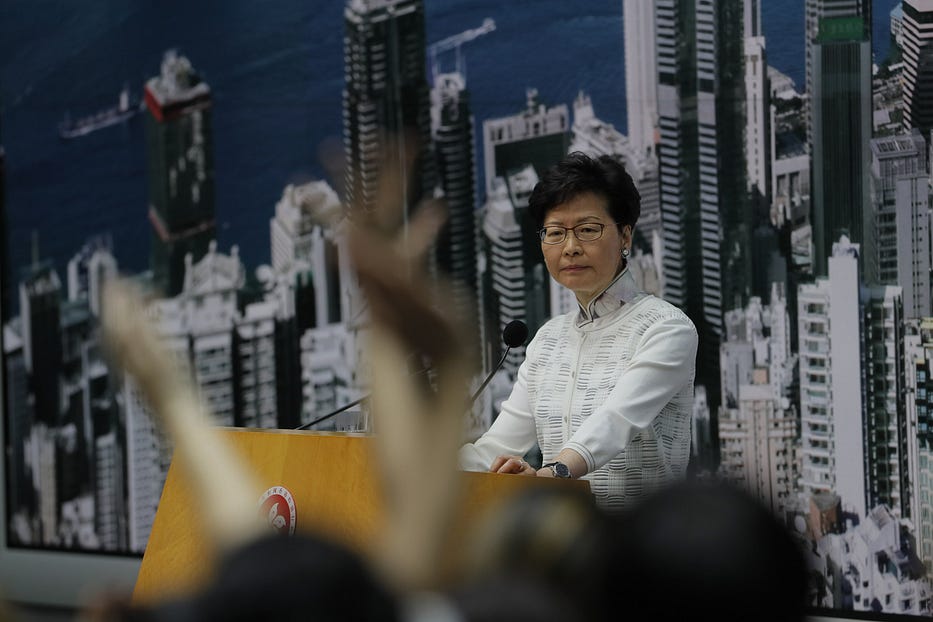
From Apathy to Activism
Ming Tak Ted Hui, Ph.D. Candidate in Chinese Literature at Harvard University, argues that Hong Kong’s future is in the balance.
Hong Kong citizens are often denounced as political apathetic. With social stability and economic development set as priorities, the former British colony has fostered an environment where there is reportedly no interest in sustained political engagement.
But recent events have prompted the city to react in an unprecedented manner — with over a million demonstrators taking to the streets to protest against the extradition bill on June 9 and around two million people turning out on June 16 to speak out against violence and injustice, Hong Kong citizens showed a heightened awareness in protecting their civil rights and the rule of law.
In Hong Kong, the integrity of its judicial system aims to ensure the freedom of expression and prevent executive overreach. Yet, since 2015, after the alleged abduction of five staff members of the Causeway Bay Bookstore by the public security bureau in China, there is a looming concern that dissidents wanted by the Chinese government could be sent from Hong Kong to the mainland for trial. From 2016 to 2017, six pro-democracy legislators were disqualified after the National People’s Congress Standing Committee (NPCSC) interpreted the Basic Law in a controversial manner.
The extradition bill is yet another troubling move that may chip away the legal autonomy of Hong Kong. The government, which initially claimed that the legal amendment was proposed in response to a case where an alleged murderer fled back to Hong Kong after killing his pregnant girlfriend in Taiwan, cannot provide enough justification as to why a sweeping simplification of the extradition arrangements to the mainland and Macau were also introduced in the bill. This provoked a quarter of the city’s population to voice their defiance. The protest is not only about the government’s proposal, but also a show of solidarity to protect the city’s well-entrenched rule of law.
To a lot of Hong Kongers, this is a decisive moment that could determine the future of their home.
The Hong Kong government would never have expected such a considerable turnout when they proposed the bill in March. Since after the Umbrella Movement in 2014, the pro-democratic party has suffered from an internal rupture, with new localists emerging as advocates for Hong Kong independence, while other activists were more inclined to support various Chinese democratic movements. Just this April, nine protest leaders from 2014 were sentenced to jail. The potential leadership vacuum in the pro-democratic party, as well as internal discrepancies in political visions, could have prevented a lot of Hong Kong citizens to come out to protest. But it did not. In an orderly and harmonious manner, hundreds and thousands of Hong Kong citizens hit the streets. The record-breaking demonstrations are important reminders for both the Hong Kong and the Chinese government that the citizens will voice their opposition whenever the “one country, two systems” framework is violated.
The reactions of the Hong Kong government regarding the protests have been extremely disappointing. In an interview conducted on June 12, the Chief Executive Carrie Lam compared the protests with the wayward behavior of a child. Positioning herself as the “mother” of Hong Kong, she considered herself as superior to the demonstrators and failed to respond to their concerns. The tone-deaf metaphor displayed an arrogance and disrespect towards all opposing opinions. Also on June 12, the police fired about 150 rounds of tear gas, which was almost double the number fired during the entire Umbrella Movement. Beanbags and rubber bullets were also fired in the name of maintaining stability. Over the years, the police have become more aggressive, and there does not seem to have enough reason to account for the force they used. It is hardly surprising why the response of the government and the police force has yielded more criticism and resistance among the people.
Growing up in Hong Kong, a strong sense of frustration has set in for my generation. We have seen the drastic deterioration of press freedoms, the frequent violation of human rights, the disqualification of lawmakers, and the silencing of calls for democracy. It is truly heartbreaking to live in an absurd era where every effort to safeguard our democracy seems to be in vain. But looking at the scene this weekend when Hong Kong protestors parted spontaneously to let an ambulance through, it reminds me of the Hong Kong I know and love. We may be rude sometimes, but we look out for one another. We may have conflicts around a range of issues, but we share the same sense of belonging. We may feel weak and timid at times, but we stand together to defend for our core values. Looking forward, we still have to stay vigilant. Only through voicing our opinion in solidarity can we prevent this space for dissent from gradually shrinking.
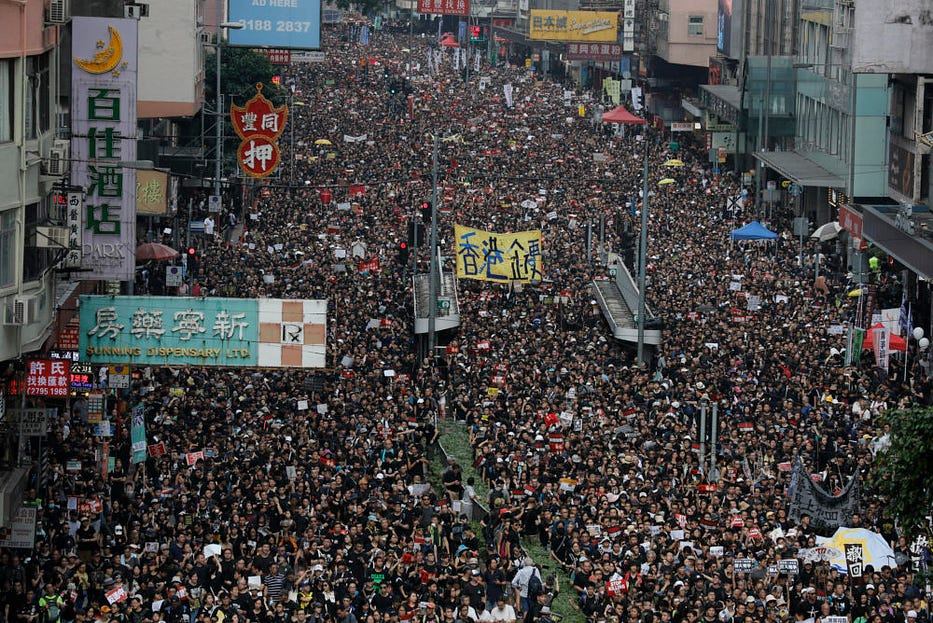
Fear and Hope for Hong Kong’s Future
Mable Chan, Associate in Research at the Fairbank Center and former ABC News producer and Hong Kong TVB News anchor/reporter, presents her hopes and fear for Hong Kong. Read Mable’s Op Ed for public radio’s WBUR.
Hong Kong is my hometown but not my future.
Thirty years ago this month, I left Hong Kong because of fear. I came to Harvard because of hope.
I became a graduate student at the Regional Studies East Asia program and studied under Professors Roderick MacFarquhar, William Kirby, Philip Kuhn and many others, hoping to better understand China.
I hoped to become a better journalist, a better person. I did not plan to become a better Chinese person or a better Hong Kong person, just a more understanding and empathetic citizen of this world. I have since become a U.S. citizen.
I have changed for the better, but not for Hong Kong.
Today, I feel horrible having left my family behind. It’s ripping me apart watching Hong Kong torn apart.
I wrote about my fear and my hope in an Op-ed essay for WBUR Cognoscenti today.
Will you share my hope?
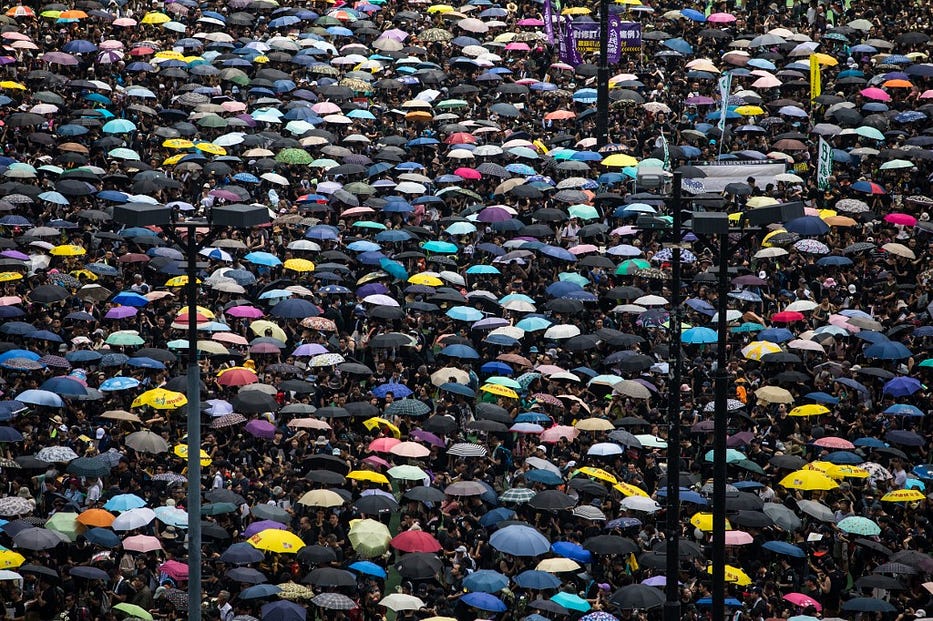
Hong Kong’s Protests in a Global Context
Helen Siu, Professor of Anthropology at Yale University, examines the recent surge in global attention on Hong Kong’s protests and political future.
I arrived in Hong Kong on June 4 and witnessed a most turbulent, volatile two weeks on the streets. The million or so protestors on June 9 were spirited, remarkably peaceful, and focused on opposing the bill. The crowd doubled in size on June 16, emotionally intense, personal, angry.
Packed like sardines, everyone endured the 6–8 hours of walking in the summer heat. I saw many young parents, some with their children, clutching signs — “Don’t Shoot,” “Our children are not rioters,” “Withdraw your accusations.” This was obviously triggered by the excessive force inflicted by police on protestors on June 12.
The mood is different from other HK protests I have seen over the years. Now, few actually expect the government to listen. People are bold, resolute, and tenacious. “No matter what the outcome, let the world hear our dissenting voices and register our anger,” the protesters seem to be saying. Clearly, the organizers appeal directly to a cosmopolitan, GLOBAL audience.
Those opposing the bill represent a wide spectrum by age, class, profession, ethnicity, and political conviction. Lawyers (including the practical-minded Law Society), chambers of commerce, diplomats, journalists, religious organizations, schools and their alumni. They are the professional backbone of Hong Kong society, whose voices have been compromised if not silenced since 1997. I am particularly moved by new immigrant groups, thousands of “home-makers and mothers,” and hundreds of small businesses that shut their doors in solidarity. This is a growing social force that is encompassing and unifying.
Strong emotions are also evident among Cantonese-speaking communities across continents. Spontaneous rallies in 29 cities in North America, Europe, Australia, Taiwan reminded me of the Umbrella Movement of 2014.
Earlier on May 26 at the Oslo Freedom Forum, singer Denise Ho proudly declared “I am [a] Hongkonger.”
What binds HongKongers as a human collective to speak truth to power?
Hong Kong has always been a land of opportunities and refuge; generations have come, experienced and gone, depositing values and taking away slices. This historically layered process is the “two systems” side of the formula. The proposed bill risks discouraging trans-local elements from participating in the life of the city out of fear, thus shrinking the social connections and diverse cultural resources Hongkongers have used to forge distinctive identities, livelihoods and lifestyles. This collective has now come together to defend their cherished humanity.
As an academic, I am alarmed by the possible long term impact of the bill. If teachers and researchers avoid particular research ideas and normal exchanges with Hong Kong for fear of unpredictable harassment, this could drastically curtail the intellectual horizons of generations of students, in Hong Kong, China, and elsewhere.
The rapid erosion of “two systems” in Hong Kong has been given much attention. What about the “One country” side of the formula? China today is not the country that many Hongkongers and Mainland Chinese pinned their hopes on back in the 1980s. Its authoritarian presence to mold society is felt in every aspect of life in China, tested in the jailing of Occupy Central activists in Hong Kong that include our colleagues Kin-Man Chan and Benny Tai, and insinuated in different parts of the globe. The extradition bill enhances China’s power of calculated arrest and prosecution. This is a conceivable scenario that the world community must reflect upon seriously and carefully: once adopted, an isolated HK could be the frontline of China’s global reach rather than a space for mediation.
I see the recent surge in global attention as a reactive, overdue appreciation for the civic energies of Hongkongers. It is not, as pro-establishment patriots believe, “organized foreign interference.” Looking ahead, if those living in democracies with sound legal traditions come together and stand by Hong Kong, it may enable the territory to use diverse resources to sustain a vibrant, civil human collective. Citizens in vast regions of Asia under the shadow of the Belt and Road initiative might share our concerns. When they are energized, it will be a truly global awakening.
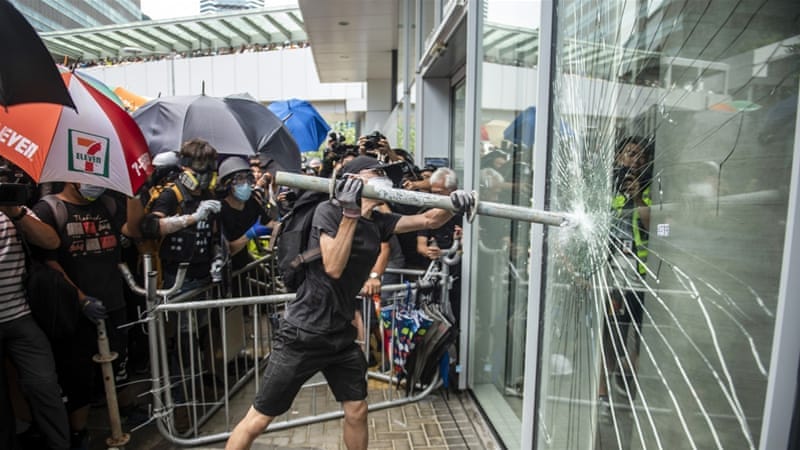
Hong Kong’s new momentum
Philippe Le Corre, Associate in Research at the Fairbank Center for Chinese Studies, Harvard University, examines the international reception to the protestor’s latest actions.
The 22nd anniversary of the Hong Kong handover will not be remembered as a smooth affair. On the night of July 1, after some 500,000 people had marched peacefully throughout the day, a group of protesters stormed into the Legislative Council building in central Hong Kong, breaking its doors, and badly damaging the interior of the local parliament.
By wanting to attract international attention in this way, it is fair to say that these protestors have tested the limits of the Hong Kong government, which has itself vastly mismanaged the situation by maintaining its proposed extradition bill. Over the past few weeks, between one to two million Hongkongers demonstrated against the bill — and above all against Beijing’s rising interference in the territory’s judicial autonomy. Protesters have accused Beijing of breaking its side of the “one country, two systems” Sino-British agreement through becoming increasingly involved in the territory’s internal affairs.
Twenty-two years after the handover, Hong Kong’s young people in particular feel that the system is not working for them. Following actions in 2003 against a law on subversion and sedition, and in 2014 regarding changes to the electoral system, which in turn lead to the Umbrella movement, this new generation of protestors is determined to attract the world’s attention to their case. They have succeeded in rallying major media outlets and political leaders in the west, but China has not given them the kind of response they were hoping for: neither a total withdrawal of the extradition bill, nor the sacking of Chief Executive Carrie Lam will happen anytime soon. Instead, Chinese propaganda has been insinuating that “foreign hands” may be behind the protests, as demonstrators also call for Hong Kong’s “freedom.”
Now that violence has occurred in the storming of the LegCo building, Beijing is analyzing the situation before officially reacting. It is going to be much harder for the movement to justify the use of violence by some of its members. Calling the violent protesters “extreme radicals,” China has been keen to discredit the movement, and the massive international media coverage (in complete opposition to the mainland) may be used against the pro-democracy movement. If it wants to be heard, the pro-democracy movement has to reassess its strategy and find alternatives to violent action. Returning to peaceful action will also help to re-engage with overseas Chinese communities and supporters of Hong Kong’s cause around the world.
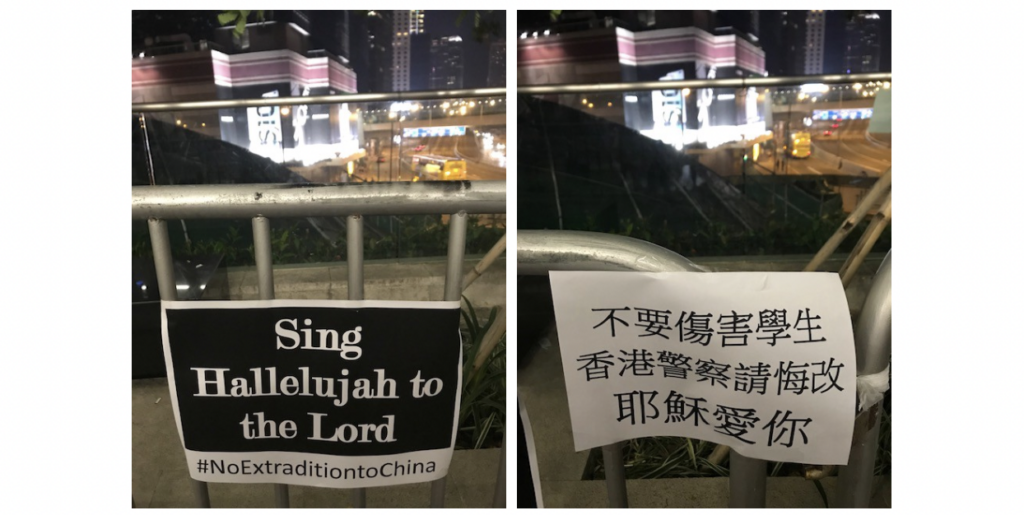
Beyond Sing Hallelujah to the Lord
Colonialism, Cold War, Identity-Transformation, and Hong Kong Protests from the Perspective of Religion
Ting Guo, Adjunct Assistant Professor at the University of Hong Kong, explores the prominent role of religion, particularly Christianity, in Hong Kong’s recent protests.
As Sing Hallelujah to the Lord has become the unofficial anthem of Hong Kong’s protest against the proposed extradition bill, elements of Daoism, Buddhism, and popular religions have also made their mark on recent events in the city. This was most evident at a makeshift shrine outside a shopping mall in the city center at which individuals left offerings to a young protestor, who tragically died the night before the 616 march. These prominent religious elements reveal an often-neglected complex religious ecology that has historically contributed to the emergence of Hong Kong’s civic community, social development, and political dynamics.
This religious ecology deserves more scholarly attention. It may help us better understand the social and political situation of Hong Kong, not only in terms of governance, but also in terms of solidarity and autonomy. Furthermore, this ecology underscores the quest for identity in Hong Kong, which has become more urgent through the political tensions between Hong Kong and China demonstrated by the 2014 Umbrella movement and the 2019 anti-extradition protests.
Buddhist Funeral Chants with Sing Hallelujah around the Block
On the evening of 15 June, a young protestor died falling off Pacific Place 太古廣場, the largest shopping mall in Admiralty, next to the Legislative Council and Central Government offices.
That night, Hong Kong protestors messaged each other to not only attend a planned march the next day, but also to dress in black and bring white flowers in remembrance of him. Memes, cartoons, and other expressions of grief and solidarity soon circulated on social media. The 616 march had become more than a protest; it was now also a funeral attended by almost two million people. It was dubbed, “ the most solemn funeral in the history of Hong Kong.”
The small, makeshift shrine to mark the young man’s death included candles, incense sticks, and fruit, all elements commonly seen at shrines reserved for one’s ancestors, Buddhist and Daoist temples, and funerals for the Chinese community. Namo Amitābha (南無阿彌陀佛), a well-known Han Chinese Buddhist chant, also played in the background. The sounds of chants, combined with the repertoire of Cantonese and English hymns sung over loudspeaker at the nearby protest at Statue Square, presented a cacophony of diverse sounds that represent Hong Kong’s multifaceted society.
While Christianity may appear more like a public institution, with Buddhism or Daoism seemingly confined to private events such as funerals or domestic settings or even associated with pro-establishment camps, it is not the case that Buddhists lack social and political engagement. For instance, the Hong Kong Network of Engaged Buddhists香港入世佛法網絡 organized a group to join the 616 protest. In addition, meditation organization Still Together一起靜 posted on their Facebook page about civil disobedience and mindfulness. In Southeast and South Asia, Buddhism is a socially engaging and politically outspoken institution. Within Han Buddhism, the Tzu Chi Foundation in Taiwan has also been challenging the argument that Buddhist institutions lack interest in social and political engagement.
Buddhist organizations in Hong Kong have been socially active in providing social services since late imperial times, and especially during the Chinese civil war when refugees flooded in from mainland China. Buddhist-run schools and hospitals were established, with today’s Tung Wah Group of Hospitals 東華三院 the inheritor of a tradition that started from a Man Mo Temple 文武廟 in 1870. Tung Wah Group remains the oldest, and arguably largest charitable organization in Hong Kong, with a wide range of ventures like iBakery 愛烘培, a café and bakery chain that trains young people with disabilities.
Nonetheless, Buddhist institutions appeared to take a backseat to Christian institutions at the recent protests. At first glance, it may appear that the visibility of Christian organizations at the protests is related to the colonial history of Hong Kong, where Christianity was the officially-sanctioned and therefore relatively more institutionalized religion of the colonial master. This explanation, however, ignores a long history in which Christianity was appropriated as a resource collaborator and ideological instrument in the post-war and Cold War eras, while Buddhism, Daoism, and popular religions have been associated with mainland ideology on the one hand, and contributing to the formation of social institutions and local Chinese identity on the other. This is especially the case in rural Hong Kong, as scholars such as David Faure and James L. Watson have demonstrated.
The Church as an Ideological Instrument against Communism: Historical Conditions for Christianity’s Participation in Politics
In addition to hymns, Christian discourse has been commonly applied against police brutality, with protestors displaying signs that read: “Stop shooting the people. Jesus loves you.” During the 616 protest, the way in which protestors gave way to an ambulance making its way through the crowd was likened to Moses parting the Red Sea. Not to mention the official namesake of #OccupyCentral in 2014, “Occupy Central with Love and Peace,” and the Christian identity of some of the most prominent activists, including Benny Tai, Chan Kin-man, Reverend Chu, and Joshua Wong.
This visible/public display of Christianity is related to Hong Kong’s colonial history, but it was not until the 1940s and 50s when refugees fleeing civil war on the mainland that the Hong Kong government began officially cooperating with churches — many of which had access to resources through international connections — on social and welfare issues for the locals. Churches offered higher quality service at a quarter of the cost than if the government ran the service itself. As church historians have pointed out, Catholic and Protestant missionaries served British troops who were dying at a rapid rate from the plague and tropical diseases. Missionaries were also asked to educate the children of British troops and government officials.
The colonial government also found that it was ideologically aligned with churches and organized religious organizations owing to their anti-communist stance. This ideological consideration also stemmed from a fear that local Chinese charities and organizations might sympathize with the mainland on patriotic grounds. Indeed, the British colonial period was punctuated by episodic eruptions of Chinese politics that penetrated into Hong Kong. The 1967 riot, for example, was a movement led by underground communists in Hong Kong. The colonial government therefore favored churches as agents that might curb the activities of communists and resist communist infiltration. In 1950 for example, Anglican Bishop Ronald Hall wrote to the Secretary of the Board of Education, suggesting:
The Government both in the United Kingdom and its colonial policy recognizes that by-in-large only religion can resist Communism and that non-religious secular primary education on a large scale will produce an atheistic proletariat as prepared ground for Communism sowing [Hong Kong Record Series 147 2/2(1), 119].
This approach took the form of a contractual system through which churches became the “clients” of the government. Churches were given authority and funding to provide education and social services through institutional channels. By enlarging the Protestant and Catholic networks through schools, hospitals, and social organizations, the colonial government was able to conveniently establish a social system against communism. In 1966, Christian political activism also led to the establishment of a Hong Kong Christian Industrial Committee to tackle labor issues, which aimed to replace labor unions established by pro-China organizations. Christian labor organizations, such as the Methodist Committee for Overseas Relief and the Presbyterian Mandarin Casework Center, worked on behalf of the colonial government and helped pacify the workforce by providing limited social welfare.
As religious scholars Vincent Gossaert and David A. Palmer point out, by 1996 Christian churches operated half of Hong Kong’s 1,354 primary and secondary schools. This helps explain why hymns are a popular repertoire for the protest, as most people are familiar with them from school. Most of the schools with a religious background, however, are located in privileged areas and considered elite institutions, meaning that Hong Kong’s religious institutional history also offers an angle to examine issues of class.
Diffused Han Chinese Religions as an Identity Marker
Although only around 10% of the Hong Kong population identifies as Christian, as a result of institutionalized support Christianity has been historically more equipped, involved, and experienced in engaging with social and political issues than Buddhism, Daoism, or indigenous forms of religious institutions.
In addition, while Christian organizations catered to the British colonizers or elites, non-Christian institutions served as governing and judicial institution for the local Chinese in the colony. In other words, the divide between the religions was not only spiritual, but racial, cultural, political, and social. Subsequently, Daoism, Buddhism, and popular religions in their diffused forms became an identity marker for Hong Kong Chinese. This history may help to explain why religious institutions other than Christianity have been less vocal about their political stance, and similarly less public when it comes to political issues in general. This religious history also emphasizes the difficulty of identity formation for Hong Kong Chinese beyond a binary framework, as the “ethnic minorities” and “new immigrants” in Hong Kong have also been struggling for recognition in everyday life, social and political institutions, and recent protests.
As religious institutions, popular religion, Buddhism, and Daoism also increasingly compete for space, resources, and official support. At the same time, they have transfigured into what sociologist C.K. Yang refers to as “diffused religions,” insofar as they are less distinct as distinct institutions that are separate from each other, with their theologies and rituals intimately merged with secular institutions, social orders, and everyday life. At the same time, practices of such diffused religions do not conflict with other religious affiliations or identities. For instance, one could be a middle-class Christian who retains diffused religious/cultural elements in family and private life. This marks and preserves a specific type of Cantonese Han Chinese identity with roots in late-imperial China, exhibited in diasporic Cantonese communities, and often in resistance to assimilation.
As an identity and community marker, this religious/ethnic/racial/cultural/linguistic identity therefore implies the difficulty of identity formation in today’s “global city” in the age of protest. The protests will likely be a long fight, one that includes changes in everyday attitudes and social institutions guarding the frontier of cosmopolitan sensibility.

